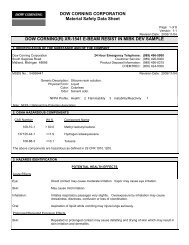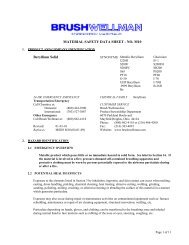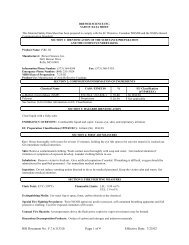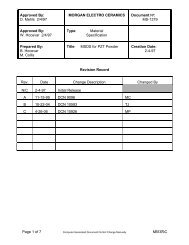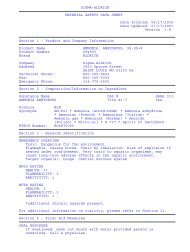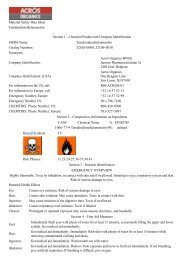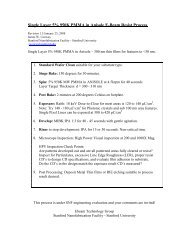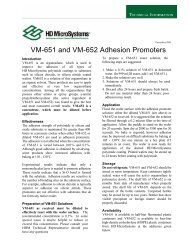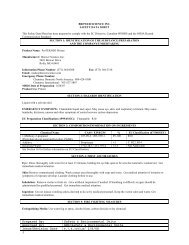EE 410 / Saraswat Handout #3 - Stanford Nanofabrication Facility
EE 410 / Saraswat Handout #3 - Stanford Nanofabrication Facility
EE 410 / Saraswat Handout #3 - Stanford Nanofabrication Facility
You also want an ePaper? Increase the reach of your titles
YUMPU automatically turns print PDFs into web optimized ePapers that Google loves.
<strong>EE</strong><strong>410</strong> / <strong>Saraswat</strong> <strong>Handout</strong> <strong>#3</strong><br />
have been processed successfully. Admittedly, this is a matter of experience and some<br />
personal judgment about the reliability of a specific process step and the risk you are willing to<br />
take of possibly losing a wafer to misprocessing for one reason or another. But a general<br />
recommendation is to perform microscope inspection on 20%-25% wafers in the batch; though<br />
certainly, inspecting all of them is also recommended, especially if you have only a few wafers<br />
to begin with.<br />
• Before putting the wafer under the microscope, take a moment to perform a visual inspection<br />
of the whole wafer.<br />
• Microscope inspection should be done in several spots across the wafer. A typical inspection<br />
would consist of an X-scan and Y-scan across the wafer, stopping at several random points,<br />
followed by area inspections at five specific points on the wafer (top, center, bottom, left, and<br />
right.) It is easiest to inspect the same die area in each of these locations, in order to make the<br />
best comparison. The area inspected should include the most critical features being defined at<br />
that particular process step (i.e., inspection for an etch would include checking for residual<br />
film, resolution, and undercutting, as appropriate.)<br />
Film Thickness Measurement:<br />
• Thickness measurements are typically done after oxidation or film deposition to ensure the<br />
appropriate film thickness is achieved. Depending on the etch, they are also done after etching<br />
to ensure the etch is complete and/or the film is completely removed.<br />
• As in the microscope inspection, select a sampling of wafers that assures YOU that the wafers<br />
have been processed appropriately.<br />
• Before putting the wafer under the microscope, take a moment to perform a visual inspection<br />
of the whole wafer.<br />
• Thickness measurements are typically done at several points across each wafer (top, center,<br />
bottom, left, and right.) Measurements may be done on blank test wafers (for example, base<br />
silicon dummy wafers which have been processed in a deposition furnace with your device<br />
wafers). Measurements can also be done in specific die locations which have the appropriate<br />
exposed film areas. Or both. Make sure to note your observations on the runsheet.<br />
• For the <strong>EE</strong><strong>410</strong> device, the measurement locations are indicated:<br />
o Four sets of fabrication test structures, located at the corners of each die (excluding the<br />
SEM structures), are provided for consistent measurement of oxide and poly thicknesses.<br />
o After definition of the active region, the fabrication test structures will be patterned on<br />
the wafers. Select any one of the 4 corners for oxide and poly measurements. Be<br />
consistent with which corner was selected.<br />
2B.2. WHEN TO INSPECT – The best places to inspect are as follows:<br />
After photopatterning wafers:<br />
• Microscope inspection of sample wafers for pattern resolution and alignment<br />
• Visual inspection for gross defects and to ensure patterning on all wafers.<br />
• Rework resist by stripping resist and repatterning as necessary.<br />
After oxidation or thin film deposition:<br />
• Thickness/uniformity measurement of sample wafers by Nanospec or profilometry, as<br />
appropriate<br />
Revised Jan. 11, 2008 Page 4/47



